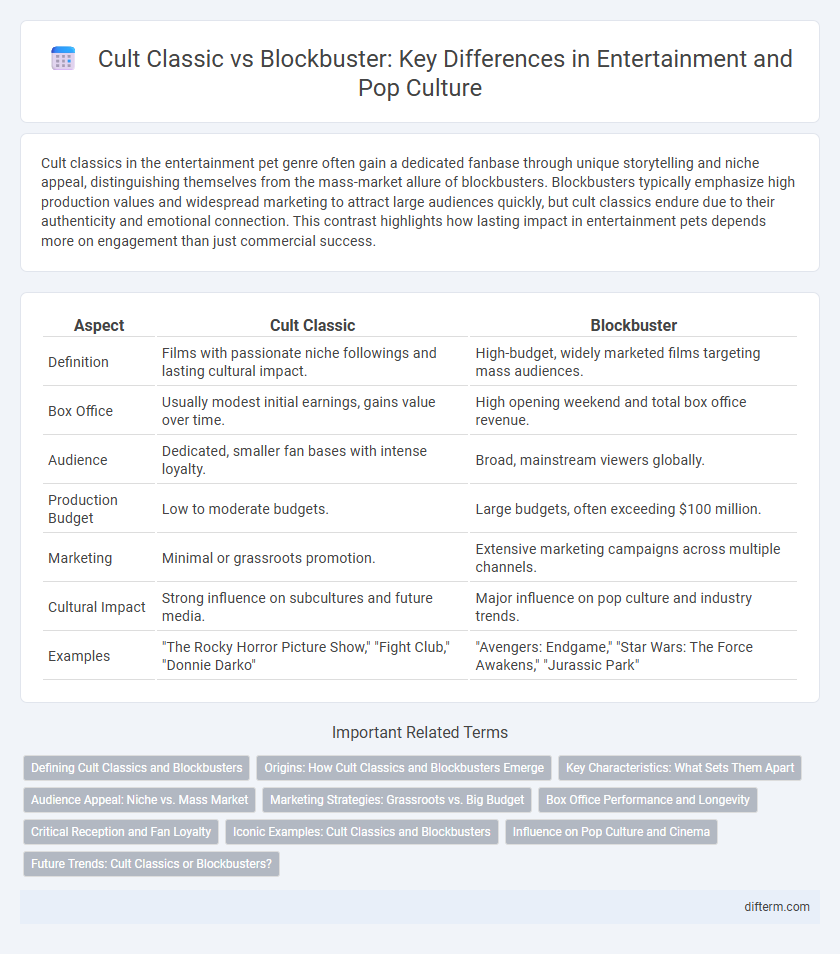Cult classics in the entertainment pet genre often gain a dedicated fanbase through unique storytelling and niche appeal, distinguishing themselves from the mass-market allure of blockbusters. Blockbusters typically emphasize high production values and widespread marketing to attract large audiences quickly, but cult classics endure due to their authenticity and emotional connection. This contrast highlights how lasting impact in entertainment pets depends more on engagement than just commercial success.
Table of Comparison
| Aspect | Cult Classic | Blockbuster |
|---|---|---|
| Definition | Films with passionate niche followings and lasting cultural impact. | High-budget, widely marketed films targeting mass audiences. |
| Box Office | Usually modest initial earnings, gains value over time. | High opening weekend and total box office revenue. |
| Audience | Dedicated, smaller fan bases with intense loyalty. | Broad, mainstream viewers globally. |
| Production Budget | Low to moderate budgets. | Large budgets, often exceeding $100 million. |
| Marketing | Minimal or grassroots promotion. | Extensive marketing campaigns across multiple channels. |
| Cultural Impact | Strong influence on subcultures and future media. | Major influence on pop culture and industry trends. |
| Examples | "The Rocky Horror Picture Show," "Fight Club," "Donnie Darko" | "Avengers: Endgame," "Star Wars: The Force Awakens," "Jurassic Park" |
Defining Cult Classics and Blockbusters
Cult classics are films that garner dedicated fanbases through unique storytelling, niche appeal, and enduring cultural significance despite modest initial box office performance. Blockbusters achieve widespread commercial success rapidly, driven by high budgets, extensive marketing, and mass audience appeal. The distinction lies in cult classics' lasting influence and loyalty versus blockbusters' immediate financial impact and broad accessibility.
Origins: How Cult Classics and Blockbusters Emerge
Cult classics often emerge from low-budget films or niche genres that develop dedicated fanbases over time through word-of-mouth and midnight screenings. Blockbusters typically originate from high-budget productions backed by major studios, with extensive marketing campaigns aiming for widespread box office success upon release. While blockbusters rely on immediate mass appeal, cult classics grow gradually, resonating deeply with specific audiences and influencing pop culture in unique ways.
Key Characteristics: What Sets Them Apart
Cult classics possess enduring niche appeal, often characterized by dedicated fanbases, unconventional storytelling, and unique thematic elements that defy mainstream trends. Blockbusters are defined by high production budgets, mass-market appeal, extensive marketing campaigns, and impressive box office revenues that dominate opening weekends. The key difference lies in cult classics' cultural impact over time versus blockbusters' immediate commercial success and widespread visibility.
Audience Appeal: Niche vs. Mass Market
Cult classics cultivate a dedicated, niche audience that values unique storytelling, unconventional themes, and deep emotional connections. Blockbusters target mass markets by delivering high-budget productions, wide appeal narratives, and extensive marketing to maximize ticket sales and global reach. Audience appeal in cult classics thrives on exclusivity and loyalty, whereas blockbusters prioritize broad accessibility and commercial success.
Marketing Strategies: Grassroots vs. Big Budget
Cult classics often rely on grassroots marketing strategies emphasizing word-of-mouth, social media engagement, and fan communities to build long-term, organic popularity. Blockbusters utilize big-budget campaigns featuring mass media advertising, celebrity endorsements, and cross-platform promotions to generate immediate global exposure and box office success. The contrast in marketing approaches highlights how cult classics depend on niche audience loyalty, while blockbusters target broad demographic reach for rapid market penetration.
Box Office Performance and Longevity
Cult classics often achieve moderate initial box office returns but gain enduring popularity through strong fan followings, cult screenings, and home media sales, while blockbusters typically dominate box office charts with massive opening weekends and high total gross revenues. The longevity of cult classics is fueled by niche appeal and repeated viewings over years or decades, contrasting with blockbusters that rely on widespread immediate success and extensive marketing to maximize short-term earnings. Over time, some cult classics surpass blockbuster films in cultural significance despite lower box office performance at release.
Critical Reception and Fan Loyalty
Cult classics often receive mixed or modest critical reception upon release but develop a dedicated fanbase through unique storytelling and memorable characters. Blockbusters typically garner widespread critical acclaim and massive marketing support, leading to immediate commercial success and broad audience appeal. Fan loyalty in cult classics grows organically over time, while blockbusters rely on high visibility and franchise potential to maintain long-term engagement.
Iconic Examples: Cult Classics and Blockbusters
Cult classics like "The Rocky Horror Picture Show" and "Blade Runner" have garnered dedicated fanbases through unique storytelling and lasting cultural impact despite modest initial box office success. Blockbusters such as "Avatar" and "Avengers: Endgame" achieved massive commercial success with high production budgets, extensive marketing campaigns, and widespread global appeal. These examples highlight the distinct paths by which films can become iconic, either through cult followings or blockbuster achievements.
Influence on Pop Culture and Cinema
Cult classics often shape niche subcultures and inspire dedicated fan communities, fostering long-lasting cultural impact through unique storytelling and innovative themes. Blockbusters dominate mainstream cinema with widespread commercial success, driving trends in filmmaking techniques, visual effects, and marketing strategies that influence global pop culture. Both forms contribute significantly to the evolution of cinematic language and audience expectations, albeit through different pathways of cultural resonance.
Future Trends: Cult Classics or Blockbusters?
Future trends suggest a growing shift towards cult classics driven by niche streaming platforms and fan-driven communities fostering long-term engagement. While blockbusters continue to dominate box office revenues through high-budget visual effects and global marketing campaigns, the rise of personalized content algorithms boosts the discoverability of cult favorites. Emerging technologies like virtual reality and interactive storytelling are expected to further blur the lines, offering immersive experiences that appeal both to mass audiences and specialized fanbases.
cult classic vs blockbuster Infographic

 difterm.com
difterm.com